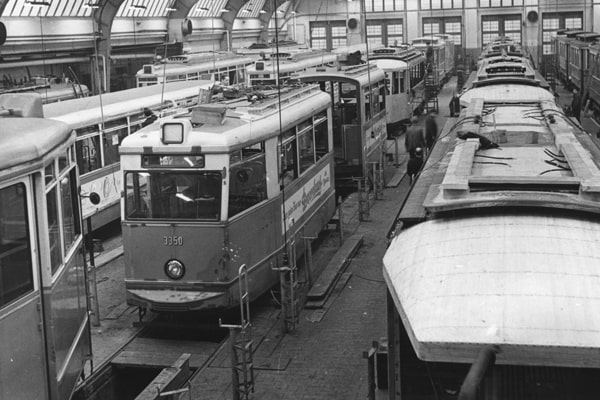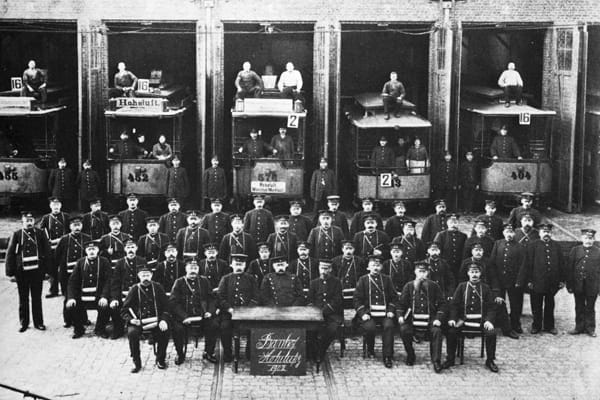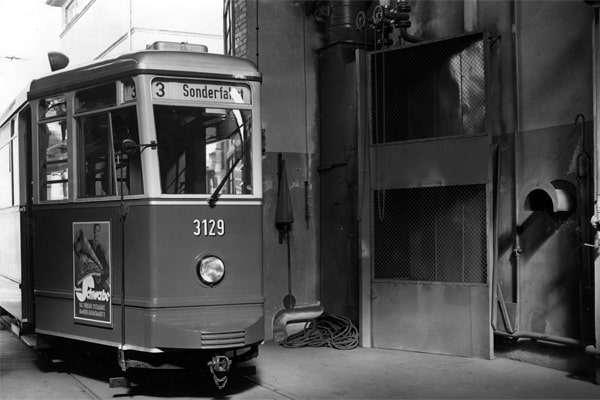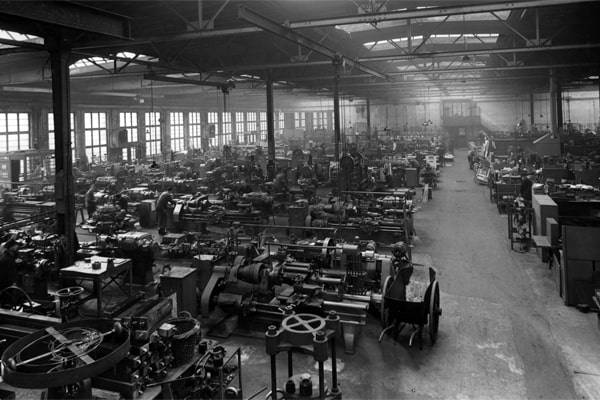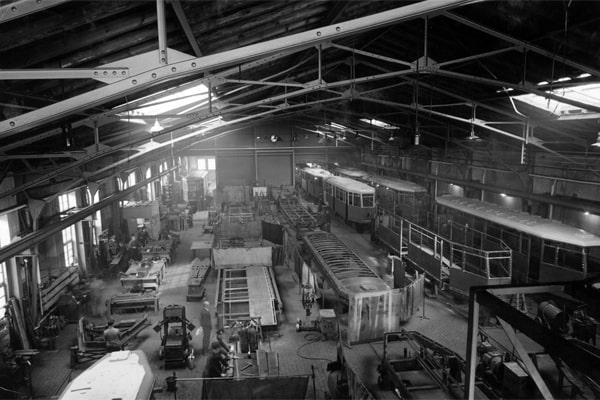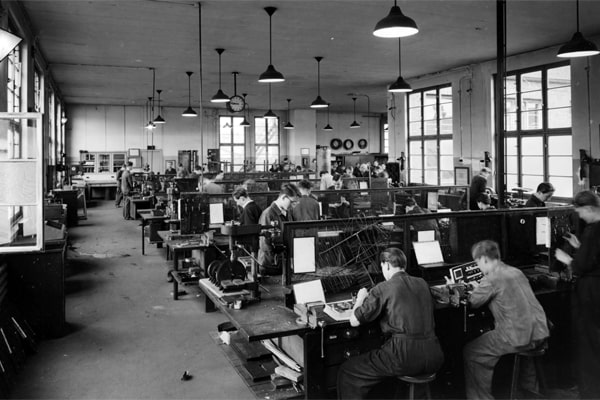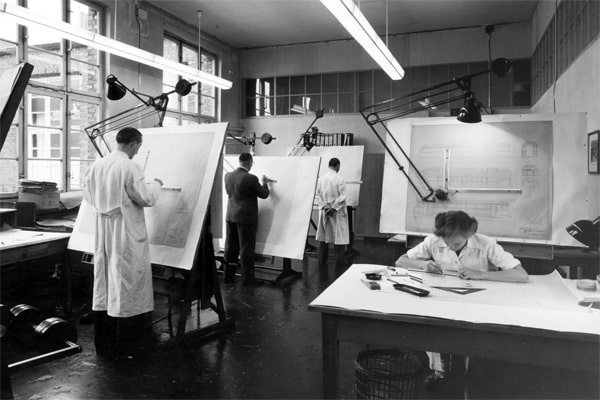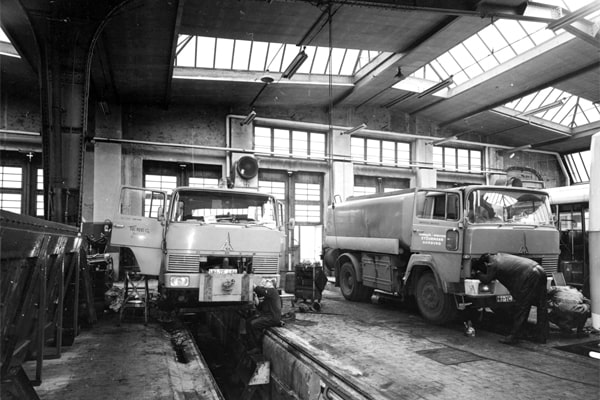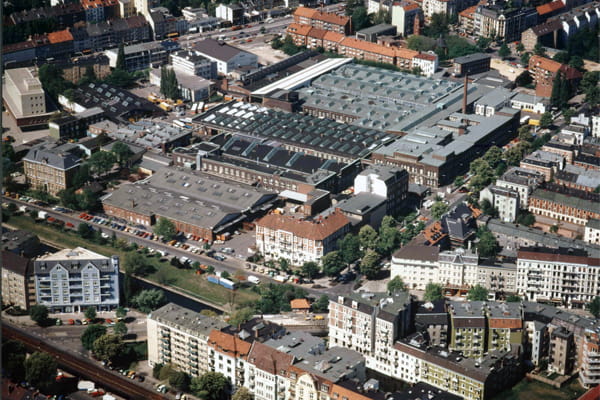The History of FFG
Innovative by tradition: Our history makes us strong for the mobility of the future.
The history of FFG Fahrzeugwerkstätten Falkenried GmbH begins in 1880, with the founding of the Straßen-Eisenbahn-Gesellschaft (SEG) in Hamburg. In 1892, it opened the Falkenried Depot, which at ten hectares was the largest depot in Hamburg at the time. Here, horse-drawn trolleys were housed, maintained and repaired in huge, multi-track halls. The stables for 300 horses are also located on the site, as well as administrative buildings and company apartments. In the 1890s, the world switched from horse-drawn streetcars to electric streetcars – Falkenried produced its first streetcars in 1894, and the depot was transformed into a production facility. The heyday of the Falkenried wagon factory began around the turn of the century: The production of electric streetcars was so successful that transport companies were supplied throughout Germany, and shortly afterwards throughout the world. By 1914, about 6,000 vehicles of all kinds were produced – not only streetcars, but also omnibuses and subway cars. In 1918, SEG became the property of Hamburger Hochbahn AG.
In 1926, the renovation and expansion of the workshops began, and the result today is an outstanding example of modern industrial architecture of the 1920s. In the following years, the number of streetcars in Hamburg reached its peak: 1,600 passenger and 165 work vehicles, as well as 130 buses. The workshops in Falkenried were working at capacity due to this large fleet of vehicles. In the mid-1950s, change arrived: The streetcar lines were gradually discontinued, as the bus and subway network was expanded. At Falkenried, experts were developing new subway railcars and public buses. In 1968, FFG Fahrzeugwerkstätten Falkenried GmbH was founded. Beginning in 1975 – with the world's first low-floor articulated pusher bus – FFG took off into the special vehicle construction sector and awarded the license for the articulated control system to Mercedes-Benz. In 1999, the company headquarters were moved from the Falkenried site in Eppendorf to Hamburg-Hummelsbüttel.
Historical highlights of FFG
- 2022
- Commissioning of the 400th meter roof workstation in our own workshops
- 2021
- 100 HOCHBAHN electric buses are serviced by FFG
- 2020
- 30 electric buses of the latest generation are serviced by FFG
- 2019
- Europe's most modern workshop for electric buses opens in Hamburg-Alsterdorf
- 2018
- FFG celebrates its 50th company anniversary
- 2017
- Special vehicles for transporting ammunition and explosives are being built for the Hamburg police force
- 2016
- Commissioning of electric buses with OppCharge function
- 2015
- Support for electric buses with fuel cells as range extenders
- 2014
- Move into one of the most modern bus depots in Europe
- 2013
- Delivery of the 15th rooftop workstation for hybrid bus repairs
- 2012
- Refurbishment of the 300th subway vehicle door in the new design of the Hamburg elevated railroad system
- 2011
- Technical support for fuel cell hybrid vehicles
- 2010
- Development and production of new roof workstations for hybrid buses
- 2008
- Production of a 10-meter maintenance platform for aircraft on a series chassis
- 2007
- The 400th bus gets a particulate filter
- 2005
- Presentation of the world's first catering lift vehicle for the Airbus A380
- 2004
- Presentation of new ambulance elevator vehicles for LUXAIR, new elevators for wide-body aircraft
- 2002
- Production of the first VIP passenger escalator in cooperation with ThyssenKrupp
- 1999
- First conversion of vehicles to hydrogen drive
- 1996
- First conversion of a vehicle to bivalent drive (natural gas/gasoline)
- 1995
- Conversion of a double decker bus for city tours
- 1990
- Presentation of the first self-propelled, fully enclosed passenger staircase
- 1988
- Development and production of baggage handling carts for Hamburg Airport
- 1984
- Development and construction of the first catering lift truck
- 1980
- Development and production of a bus series – city, intercity and double-decker bus – for Ireland
- 1979
- Exhibition of the large-capacity rescue vehicle for the Hamburg Fire Department at the IAA
- 1978
- Production of the car body for the Transrapid magnet levitation train
- 1977
- Licensing of the buckling angle control to Mercedes-Benz, start of spare parts production for Mercedes-Benz
- 1975
- World first: Low-floor articulated pusher bus with worldwide patented articulation control system
- 1973
- Development and production of a rail cleaning vehicle for streetcars
- 1972
- FFG focuses on the maintenance, development and testing of regular service buses
- 1968
- Hamburger Hochbahn AG founds FFG Fahrzeugwerkstätten Falkenried GmbH on June 19
- 1966
- Concept for a standard line bus
- 1958
- Development of new metro railcars
- 1945
- Reconstruction of the subway cars destroyed in World War 2
- 1935
- Production of 4-axle steel construction subways
- 1926
- Renewal and expansion of the factory halls
- 1918
- Straßen-Eisenbahn-Gesellschaft (SEG) is taken over by Hamburger Hochbahn AG
- 1914
- The 6000th vehicle leaves the workshops at Falkenried
- 1911
- Hamburger Hochbahn AG is founded – 80 elevated train cars are manufactured by SEG
- 1903
- A tramcar built by SEG receives the silver medal at the German City Exhibition in Dresden
- 1894
- Production of the first streetcars for Hamburg
- 1892
- The former Straßen-Eisenbahn-Gesellschaft (SEG) starts operations at the Falkenried wagon factory in Hamburg-Eppendorf

